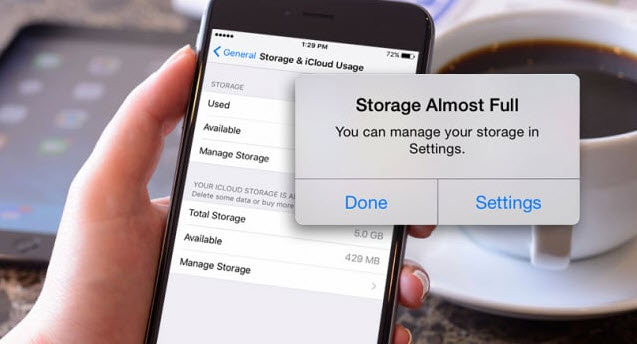(单词翻译:单击)
Data and data storage are in a never-ending arms race.
数据和数据存储就如同一场永无休止的军备竞赛。
The size and cost of memory shrinks while video and photo resolutions go up, and file sizes balloon.
视频和照片的分辨率在不断地提高,文件的大小也在不断地膨胀,而内存的大小和成本却在不断地缩小。
The end result is you just never seem to have enough room on your phone or laptop for all your stuff,
最终的结果就是,你的手机或笔记本电脑似乎永远没有足够的空间装下你所有的东西,
and you have to choose which photos of your cat to delete
所以你不得不选择删除你家猫主子的部分照片,
so you can take more photos of your cat right now cuz she's doing something so cute.
这样你才能接着在她做出非常可爱的动作的时候给她拍照。
But there's a limit to how small magnetic storage can get, and scientists are inching towards it.
然而,磁存储器的容量是有限的,而科学家们正在一点一点地接近这一极限。
The basic building block of data is a bit, represented by either a 1 or a 0.
数据的基本组成单位是字节,由1或0表示。
The basic building block of ordinary matter is an atom.
普通物质的基本组成单位是原子。
So scientists have been trying to store a bit using a single atom.
科学家们一直在试图用一个原子来存储一个字节的信息。
It actually makes sense when you think about it.
仔细想想的话,这样做其实还是有道理的。
Magnetic storage has been common in computers since the 1950s,
自20世纪50年代以来,当时硬盘驱动器的容量才4MB左右,体积却有冰箱那么大,
when hard disk drives held a whopping 4-ish MB and was the size of a refrigerator.
磁存储器在计算机中的应用已经很常见了,
Magnets have a north and south pole,
磁铁有南北两极,
so depending on which way they're oriented they can represent a one or a zero.
根据这两极方向的不同,它们分别可以代表1或0。
Usually magnetic fields are only noticeable when the magnetic fields of whole clusters of atoms are aligned the same way,
通常,磁场只有在一堆原子的磁场方向都朝同一个方向时才能够被注意到,
but zoom in closer and you'll see the electrons of atoms basically act as tiny magnets in and of themselves,
但把磁场放大,你就会发现原子里的电子本身及其内部基本上都在扮演一个小磁铁的角色,
so theoretically a single atom could be enough to represent a bit.
所以,从理论上讲,一个原子就能代表一个字节。
But down at that atomic scale, things can be chaotic.
不过,到了原子维度,情况就可能变得十分混乱。
Atoms are extremely sensitive to their surroundings, which can cause their north and south poles to flip.
因为原子对周围的环境极为敏感,这就可能导致它们的南北两极发生调换。
To store data reliably, scientists need to prevent this flipping,
要想稳定地存储数据,科学家们就要阻止原子的南北两极发生调换,
and most experiments in single atom data storage solve this problem with extreme cold.
而大多数单原子数据存储的实验都用超低温解决了这一问题。
In July of 2018 one experiment used holmium atoms as their magnets, and subjected them to extreme conditions.
2018年7月,某实验用钬原子作为磁体,将其置于极端条件下,
They found the holmium atoms retained their magnetization even in a very strong magnetic field of 8 Tesla,
他们发现,钬原子即便在8特斯拉的强磁场中也能保持其磁化强度,
so long as they were kept below 45 Kelvin.
只要将原子的环境温度保持在45开氏度(-228.15摄氏度)以下。
Still the researchers hope that the holmium's resilience points to more stable data storage at less extreme temperatures.
尽管如此,研究人员还是希望钬原子能在不那么极端的温度下提供更稳定的数据存储。
And finally in September of 2018 scientists announced they had come up with a different approach to single atom storage altogether.
终于,在2018年9月,科学家们宣布他们已经研究出了一种完全不同的单原子存储方法。
Using cobalt atoms on a background of black phosphorus,
通过将钴原子置于黑磷环境中,
the scientists created an energy difference between the cobalt atom's orbitals, or the regions where electrons orbit the nucleus.
科学家们让钴原子的轨道,即电子围绕原子核运行的区域,之间产生了一个能量差。
This allowed them to use the electron's orbital angular momentum to create the bits,
这就使得科学家们能够利用电子的轨道角动量,
instead of their spin angular momentum like in previous experiments.
而不是像之前的实验那样用它们的自旋角动量来创造比特。
Changing the orbital angular momentum has a bigger energy barrier,
改变轨道角动量能产生更大的能障,
which should make the bits more stable at higher temperatures,
比特便能在更高温度的环境下变得更加稳定,
though they've only been tested in extreme cold so far.
尽管迄今为止的测试都还局限在极冷的环境之下。
Even if scientists make single atom storage stable at room temperature,
即便科学家让单个原子在室温环境下的存储功能变得稳定了,
there are still other problems to solve before it goes mainstream.
在这种存储成为主流之前我们依然还有很多困难需要克服。
Data also need to be easy to write with acceptable signal to noise ratio.
数据还得易于编写,同时具有可接受的信噪比。
Most experiments in single atom data storage use a Scanning Tunnelling Microscope
大多数单原子数据存储实验都是用扫描隧道显微镜,
to arrange the atoms one by one, which is not effective enough for practical use.
对原子进行逐个排列,实际应用起来其实并没有那么有效。
Single atom storage has a long way to go, and in the meantime,
距离用单原子进行存储,我们还有很长的路要走,
it looks like I'm just not going to have enough space for more pictures of my cat.
所以,貌似我还是没有足够的存储空间来给我家主子拍照。
So storage on atom might take a while, but DNA data storage could be here in a few years.
虽然实现原子储存可能还需要一段时间,但DNA数据存储可能用不了几年就能实现了。
Check out our video about it here.
这期视频就讲到了这个问题,快去看吧。
Fun fact, there are also some scientists out there trying to store data on a single ELECTRON!
‘趣事实’,也有一些科学家已经在尝试往单个电子上存储数据了!
It's called electronic quantum holography,
就是所谓的“电子量子全息存储”,
and it's very confusing, please don't make me do a video about it.
这个讲起来就非常伤脑筋了,求你们千万别让我做视频讲这个!
Catch ya next time on Seeker!
我们下期节目再见喽!


